
| ||
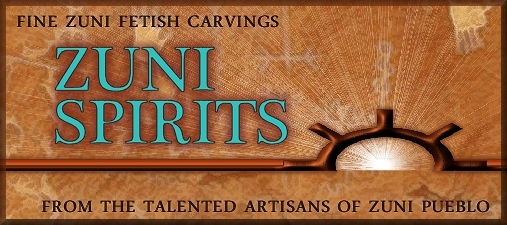 | ||
???????????? ZUNI FETISHES | WHAT'S NEW? | LINKS | CONTACT | SEARCH |
||
STONE INFORMATION - ZUNI FETISH
| ||
The Zuni fetish carvers now have access to a "world" of carving materials. It's not unusual to find stones at a Zuni trading post that were mined from countries on the opposite side of the globe. Additionally, Zuni fetish traders often supply carvers with materials they've hand chosen from various sources. Some carvers attend various Gem & Mineral Shows to buy unusual and newly found carving materials. | ||
We are not geologists but we've put together this page to assist collectors in identifying stones and to educate about the origins of some materials. We will not address chemical composition, MOHS hardness or new age beliefs. Instead, we will offer what little knowledge we may have about the stone as it relates to Zuni fetish carvings; its origin, carvers who regularly utilize it, etc. | ||
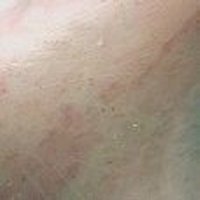
| ALABASTER: A very soft stone (that can be scratched with your fingernail) that has been carved for thousands of years by many cultures. Found globally but most of the alabaster carved in Zuni probably comes from Colorado. There is extensive information about alabaster at this link on Wikipedia. | |
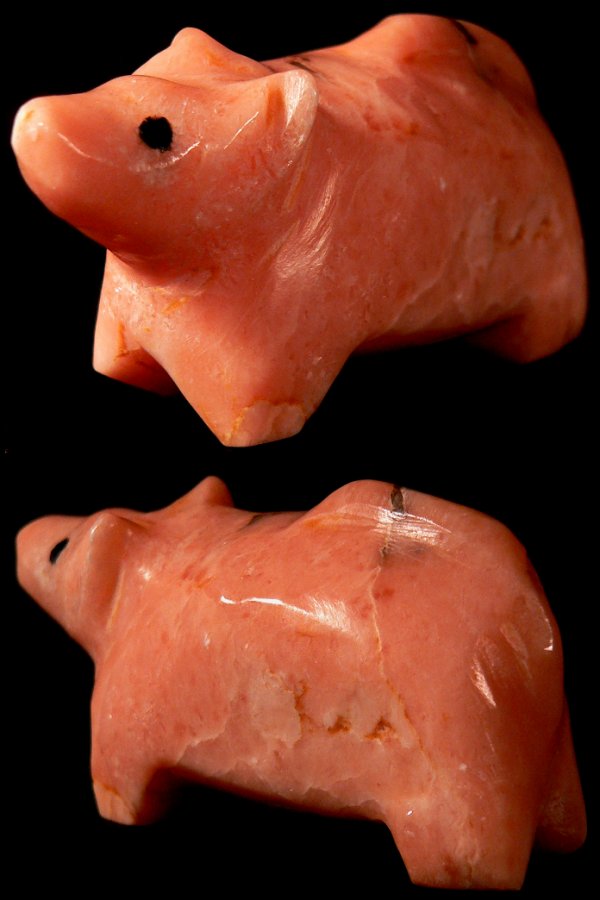
| ||
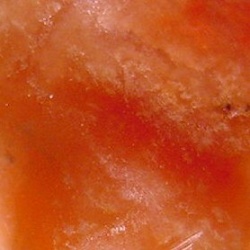
| ALABASTER, Orange: This form of alabaster usually comes from Utah and it is usually very translucent and glows beautifully under the light. It is usually free of inclusions, "fractures" or clouding. | |
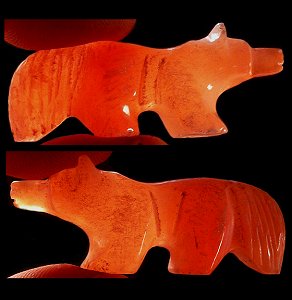
| ||
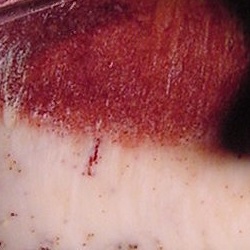
| ALUNITE: Relatively new to Zuni carvers (the last ten years or so), this material comes from likely comes from Colorado but it also found in South America, Europe, Asia and Australia. Alunite can be a variety of colors - beige, brown, maroon, white - and all shades in between. Read more about alunite at this link on wikipedia! | |
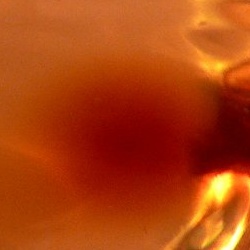
| AMBER, BALTIC: This fossilized pine resin comes from the area surrounding the Baltic Sea - Russia, Poland, Germany - where it often washes up on the beach. Melissa Quam uses baltic amber frequently for her smoothly rendered buffalo and bear carvings. Gibbs Othole, Jeff Tsalabutie and Maxx Laate also often carve their fetishes in amber. Baltic amber is 35 - 40 million years old and is older than Dominican amber. However, German amber mined at Bitterfeld is also classified as baltic amber but is only 20 million years old. | |
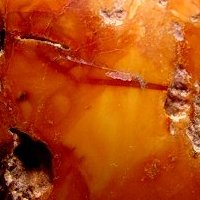
| AMBER BUTTERSCOTCH: This is merely a cloudy form of baltic amber. | |

| AMBER, DOMINICAN: This younger form of amber is 15 to 45 million years old and is usually transparent. It also has more fossilized inclusions (insects) than Baltic amber. Dominican amber can be yellow, honey-colored, red or (very rare!) blue. Copal amber is much younger (and not carvable) at only 15 million years old. There's more at wikipedia! | |
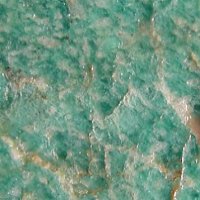
| AMAZONITE: This is a material that seems to come and go with some irregularity in Zuni. We've seen Lena Boone and Gibbs Othole use it more frequently than other carvers and they are good friends so it is possible they were sharing a large specimen. It's an interesting stone and you can read more about it here @ Wikipedia. | |
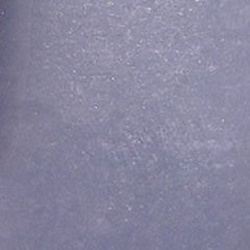
| ANGELITE: It's "real" name is anhydrite and it is a fairly It is found in Germany, Mexico, Peru and New Mexico in the US. Though anhydrite is a fairly common mineral, rock specimens of it are rare. It ranges in color from pink to baby blue and exposure to UV rays will cause the color to fade. It's not a material that we see frequently but it is used by a variety of carvers when it is available in the Pueblo. Jeff Tsalabutie and Gibbs Othole favor it when available. | |
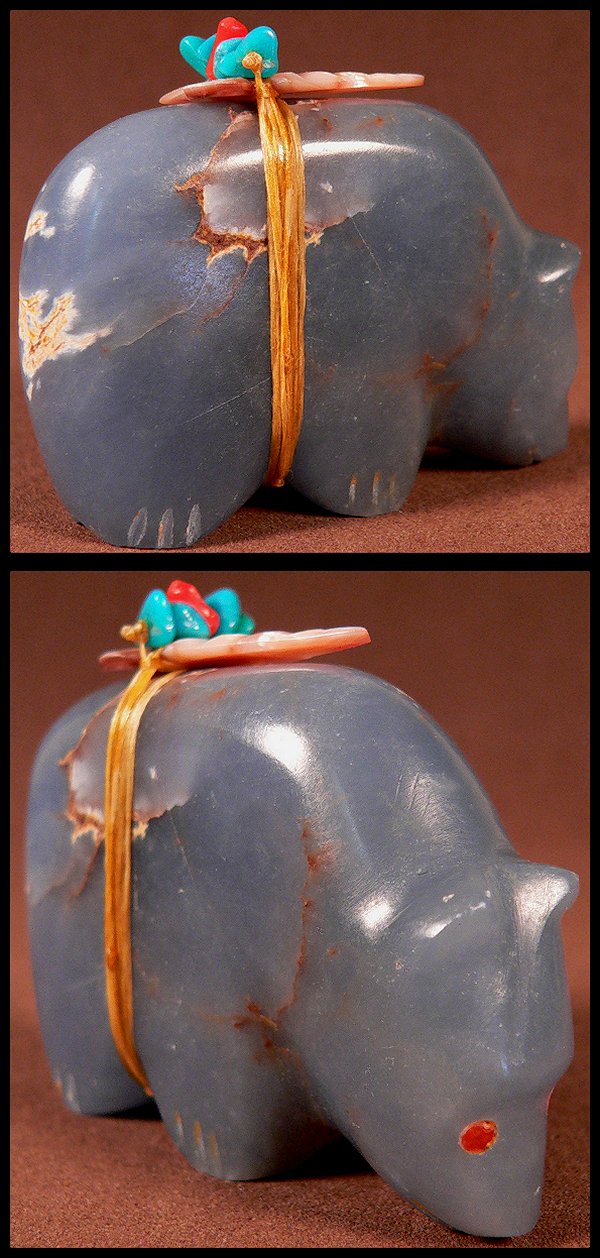
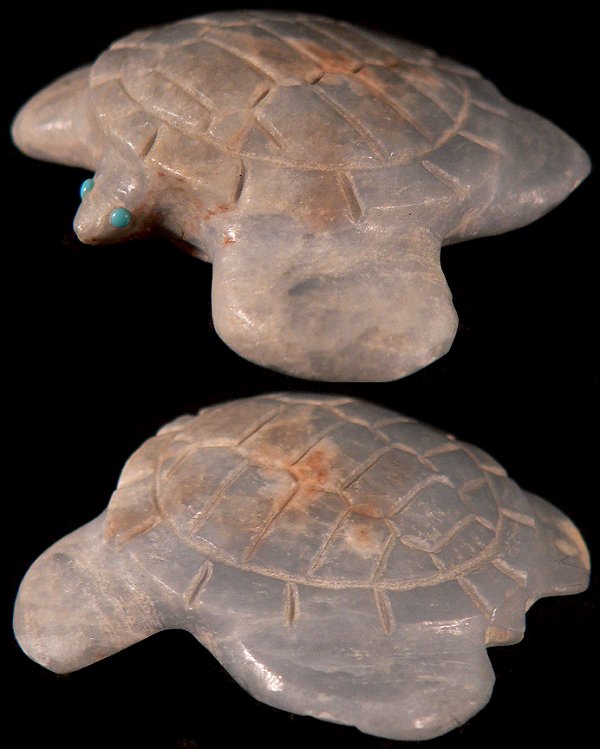
| ||
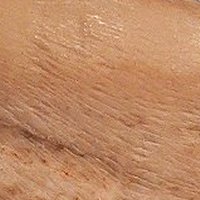
| ANTLER: Both Elk and mule deer antler are used by the carvers in Zuni. Daniel Weahkee has even carved moose antler in the past. Some carvers will use only the base (burr) while others use the tines and some carvers (Governor Norman Weahkee) have used an entire half-rack. Claudia Peina and her half brothers, Troy & Gabe Sice use antler very frequently for their maidens and bears. It's a durable material but seems to be favored by dogs and cats for chewing, so collectors beware! | |
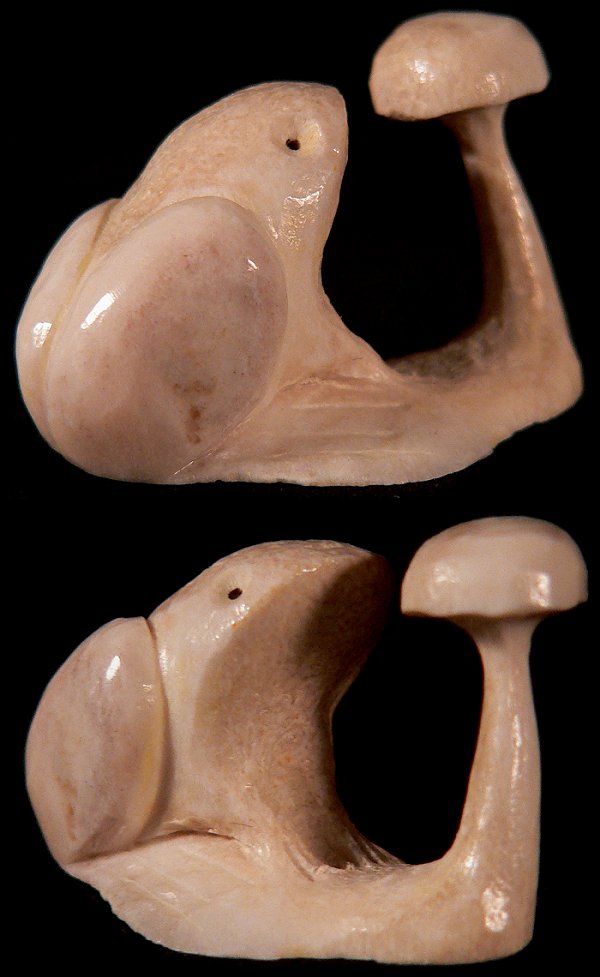
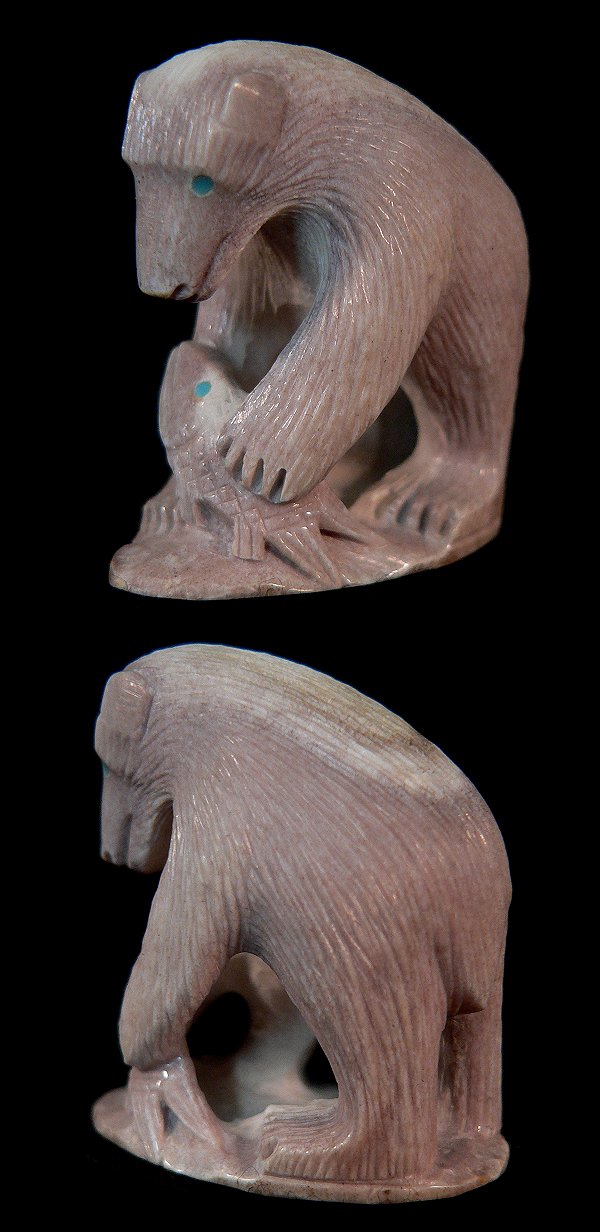
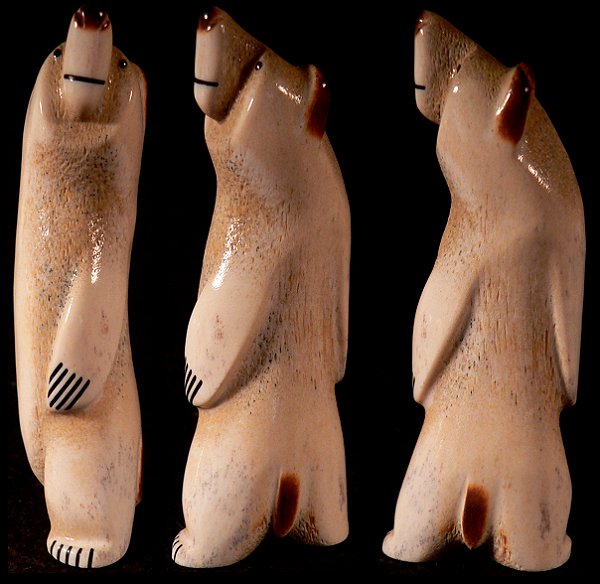
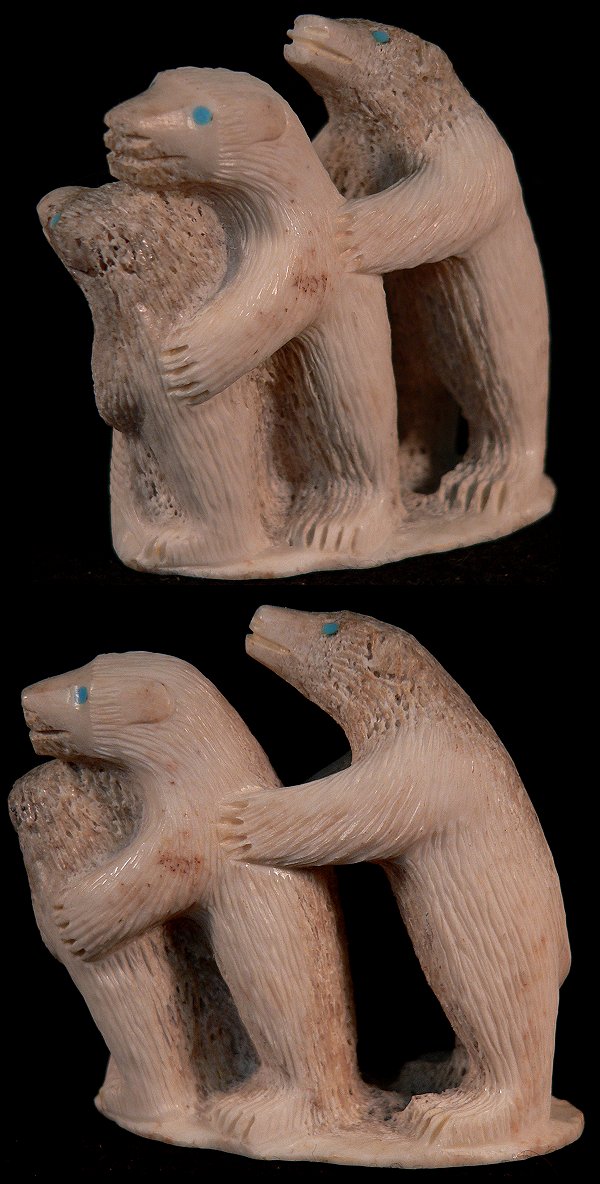
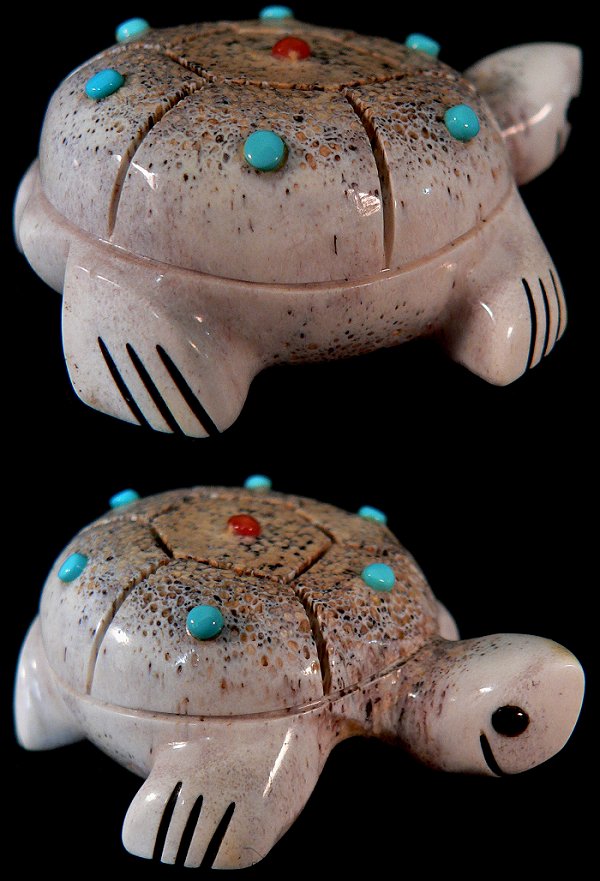
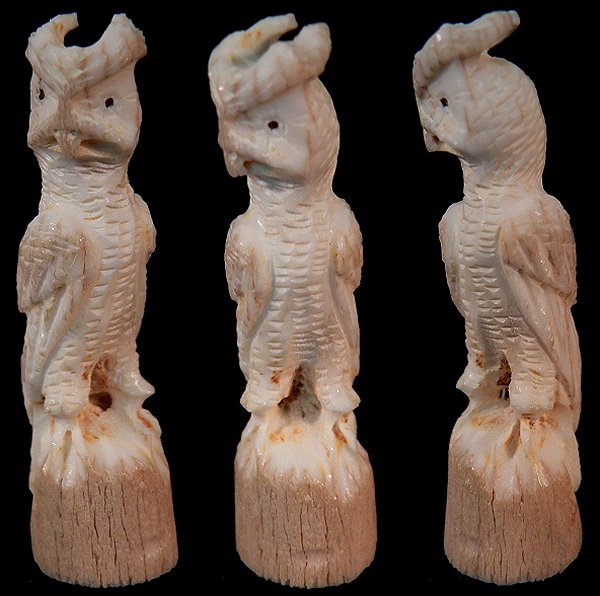
| ||
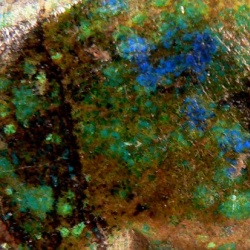
| AZURITE - MALACHITE: This composite copper complex mineral is commonly found together along with Chrysocolla, tenorite and (sometimes) cuprite. Usually located in areas that copper is mined or where copper has leached into surrounding stones. Azurite is the blue color while the malachite is green. Used fairly frequently by Prudencia Quam and Jayne Quam. These semi precious stones are also used in jewelry. | |
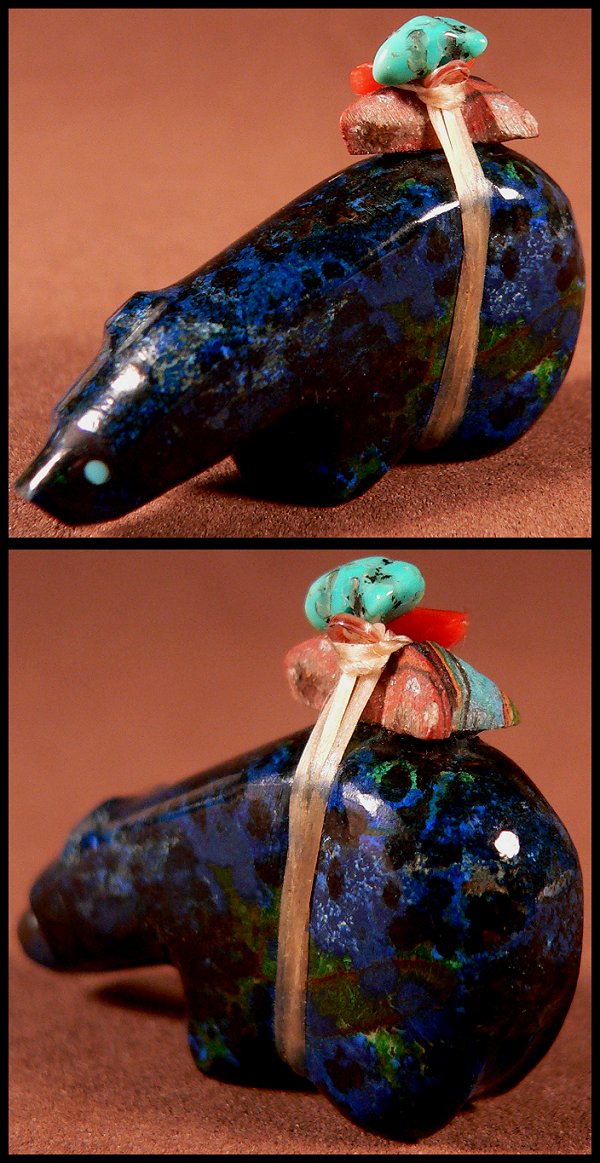
| ||
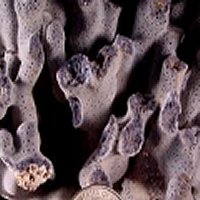
| BLUE CORAL: We purchased a quantity of this material but when we learned that the Indonesians were dynamiting the reefs in order to harvest the stuff we stopped buying. It is unsuitable for carving in its raw state. We gave some pieces to Gibbs Othole and he did make a few fetishes but the coral is extremely porous and soft. It is best reserved for decorating salt water aquariums -- but do you really want to support the destruction of reefs in order to make your own artificial one? | |
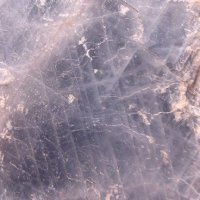
| CALCITE, BLUE: | |
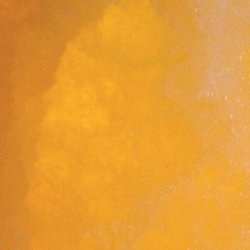
| CALCITE, YELLOW: | |
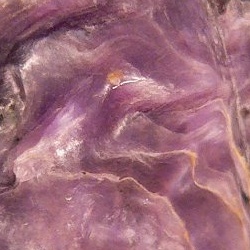
| CHAROITE: This stone was first discovered in Russia and is appreciated for its chatoyancy (swirly colors and semi translucent) and color. It varies from lavendar to deep purple, blue and black inclusions. | |
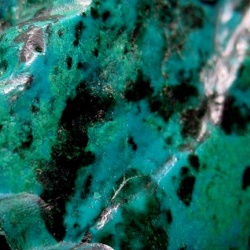
| CHRYSOCOLLA: Another of the much desired "turquoise colored" copper complex materials. Carvers seem to love it for it's varied blue-green color and it's far more economical than turquoise (for carving material). Some forms of Chrysocolla (i.e., gem silica) are highly sought by jewelry makers for cabochons. Much of the carving quality Chrysocolla used in Zuni comes from Arizona. Emery Eriacho uses this stone for his bears but many other carvers use it according to availability. | |
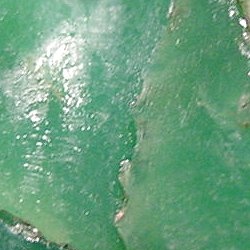
| CHRYSOPRASE: This is a very hard precious material. The highest quality material comes from Tanzania. Not used frequently for Zuni fetishes and expect to pay top dollar when you find one! The stone has beautiful sea-green color that is translucent. | |

| COLORADO RED STONE: Colorado redstone is a material that (to our knowledge) is used exclusively by Manuel and Daniel Weahkee. The Weahkee's have relatives who live very near Mesa Verde and it's a place that Daniel frequently hikes for inspiration. During one of these visits he and a park ranger were visiting and upon learning that Daniel was a Zuni fetish carver, the ranger showed Daniel some fetish carvings that are artifacts from the Mesa Verde ruins. Some of these fetish carvings were made of a red material that was not pipestone, dolomite or serpentine. Daniel was intrigued by the stone and wondered at its origins. Not long after, while hiking near his cousin's home he found a similar stone which he collected, took home and carved. He's convinced that it is the same stone the Mesa Verde artifacts are carved from. He now mines this stone to use in his fetish carvings as homage to his Puebloan ancestors. | |
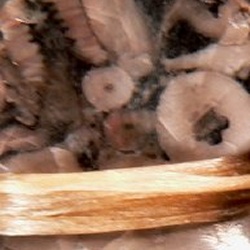
| CRINOID FOSSIL: Crinoid fossils look like plants but are actually animals that have attached themselves to the sea floor. Though they still exist (450 million years!!!) in our contemporary world (called Sea Lillies or Sea Fans), the fossils in this carving material are so ancient and are found in several geologic ages (Ordovician, Triassic, Jurassic and Paleozoic). You can read more about the animals themselves at this link on Wikipedia. The fossilized material is not used frequently but is quite striking visually. It is found globally in ancient sea beds. | |
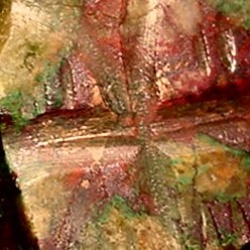
| CUPRITE: This is one of the rarer copper complex materials (usually red) and is found as inclusions in chrysocolla, turquoise, azurite, malachite and other related minerals. | |
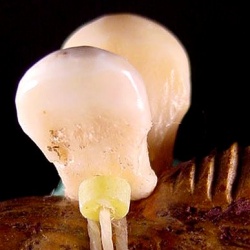
| DENTALIUM: Teeth! Used by Native Americans for decoration to clothes, jewelry, etc. The only carver we have ever seen use dentalium (elk or buffalo teeth, in this case) is Manuel Weahkee. | |
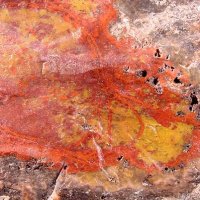
| DINOSAUR BONE: EXTREMELY HARD. Carvings made from this material are quite rare and likely expensive as the carver will burn through many bits and wheels to finish a piece made from petrified bone. Pretty colors though! | |
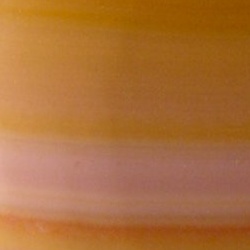
| DOLOMITE: This material is quite commonly used by Zuni fetish carvers due to it's availability, softness and varied colorful patterns. It can be pale yellow to adobe red and all shades in between. It can be banded or solid in color and is metamorphicized limestone meaning it's limestone that has been highly compressed. Sometimes found with travertine and included with onyx .. water plays a big part in this stone's creation and most of the dolomite used in Zuni comes from Arizona. | |
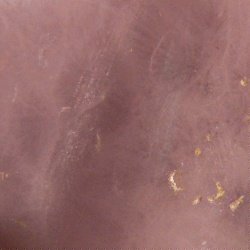
| FLUORITE, Purple: This is a common mineral mined in crystalline form. Most of the material carved in Zuni comes from Mexico but fluorite (purple and other colors) is also mined in Argentina, Russia and other global locations. Often this material appears fractured but, in most cases, this is just the appearance of the stone and not an indication of integrity. Appreciated for it's light refracting qualities it is also used in jewelry. | |
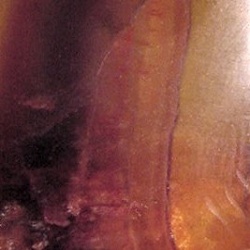
| FLUORITE, Rainbow: This form of fluorite is primarily found in Argentina and the colors will vary from teal to purple but we have seen examples where banding occured and shades of yellow, green and red were included. This material is a fairly recent addition to the carving materials available in Zuni. | |
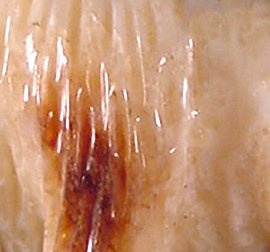
| FOSSILIZED IVORY, WALRUS: This fossilized material comes from the tusks of walrus who died and their tusks were either buried or lost at sea. Harvested LEGALLY in the US by only the Native population of Alaska though it is also found in the Arctic regions of Canada and Russia. Fossil ivory will vary in color due to the leeching of ground minerals in the porous surface during countless thaws and freezes of the permafrost. Used by a select few carvers in Zuni, Florentino Martinez, Colvin Peina (d.), Claudia Peina, and the Quandelacy sisters included. One way to identify fossilized walrus ivory from other forms is that the core will be crystalline (if it is a tusk) or hollow (if it is a tooth.) | |

| GLASS, Murano: This beautiful colored glass is made by the artists of Murano island, Italy. In recent years it has found its way to Zuniland via a gift shop that supplies broken shards to Lena Boone. She and Leland have both carved amazing fetishes from salvaged glass pieces that otherwise would have been thrown away. It is distinctive from ocean glass or slag glass in that it will be brightly multicolored and may have artistic inclusions of bubbles, fish, birds or other decorative features. To our knowledge ONLY Lena and Leland have used this material for Zuni fetishes. | |
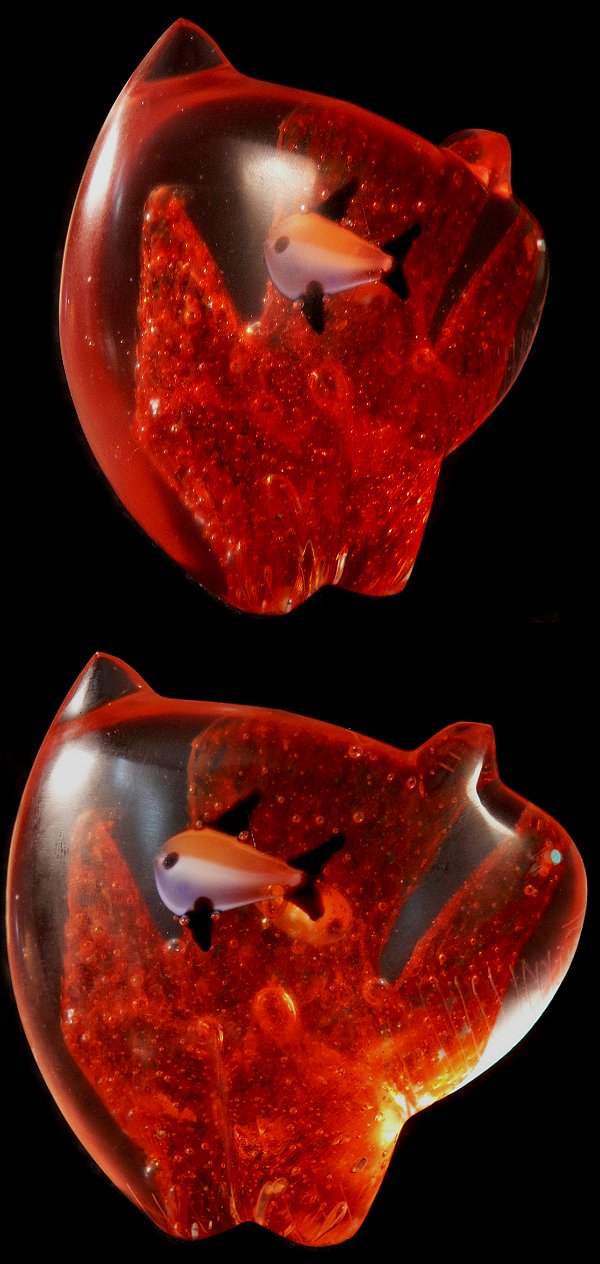
| ||
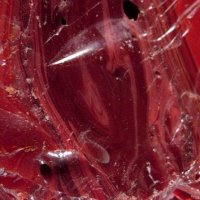
| GLASS, Red Slag: This material is a by-product of gold production. In years past we saw Abby Quam use it but it's toxic properties were prohibitive when she became pregnant. In later years we haven't seen many pieces but Lena Boone and her children have both carved it. Though it is MOSTLY red in color, it can be blue, yellow or orange. | |
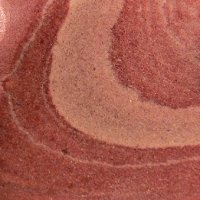
| HICKORYITE: A type of jasper found the deserts of the southwestern United States. Known for it's wood-like grain, it can be quite colorful and interesting. It is a hard material that is also used for jewelry making. | |
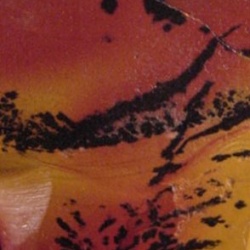
| INDIAN PAINT ROCK: This colorful material is found only in the Mojave desert on BLM property that is now closed for mining, rock collectors and the like. Consequently will become increasingly rare. Hold 'em if you got 'em. | |

| JADE: Carved by Asian artists forever, this beautiful green stone can be translucent or opaque. It was also a sacred stone to the Aztecs and Mayans (see "Apocalypto" movie for evidence of this in the royal garb during the offerings to the Sun God.) In Zuni we don't see much of it in recent years though Bernie Laselute seemed to use it almost exclusively for a while there. American jade is found in Montana, Washington and Oregon. | |
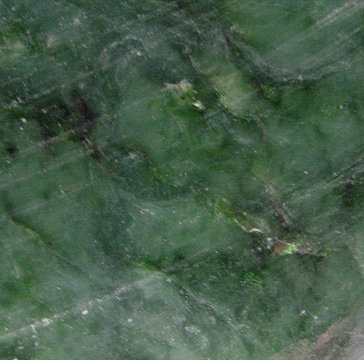
| JADE, British Columbian: This material is similar in color and hardness to the jade found in China and Russia. We have never seen a Zuni fetish made of BC jade but it's possible they are out there. | |
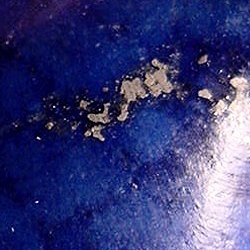
| LAPIS: This gorgeous stone is (apart from clear speciments of azurite) the deepest blue material carved by Zuni artists. It is found in Russia, Afghanistan, Pakistan, China, India and Peru. It can vary in color from pale blue with cloudy veins to the purest royal blue. It's been utilized for jewelry since ancient times. As a carving material it is very expensive. Some specimens will be included with pyrite. | |
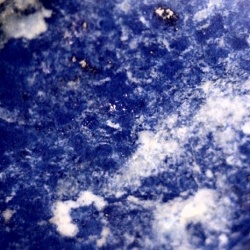
| LAPIS, AFGHAN: The best quality lapis found on earth is from Afghanistan. The Hindu Kush region has been fought over for centuries due to the quality of this stone. As a rule, it is too expensive for most Zuni carvers but there have some beautiful fetishes made by Gibbs Othole, Jeff Tsalabutie and Lena Boone from quality Afghan lapis. | |
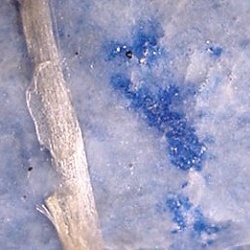
| LAPIS, Denim: This type of lapis comes from Peru and is generally a lighter (faded denim) shade and included with calcite quartz and pyrite. More affordable but less desirable to most than Afghan lapis. | |
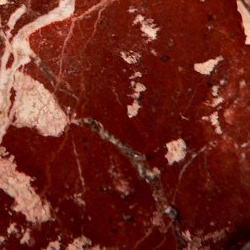
| MAGNASITE HEMATITE (aka "Wild Horse"): This material showed up in Zuni about ten years ago. It's a deep maroon with white patches and quite distinctive . The carvers went crazy for it. The story we got was that the miner said a solitary wild mustang hung out near the mine - hence the nickname "Wild Horse". Stories like this are often told to sell rock so who knows really. It's mineral name is magasite hematite and it is very simiar to howlite in appearance. Haven't seen much of this in the last 3 -5 years. Maybe the horse moved. | |
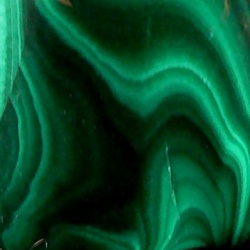
| MALACHITE: GORGEOUS green stone with amazing banding, bubbles and geode-like formations inside. We've heard the dust from malachite is toxic and with less-than-desirable ventilation set ups some Zuni carvers avoid it entirely. Abby Quam used to carve it frequently but Jimmy Yawakia carves it EXCLUSIVELY. The really pretty stuff comes from the Congo basin of Africa. But the mineral malachite can leach into sandstones and limestones to form copper complex materials (like azurite, chryscolla, etc.) | |
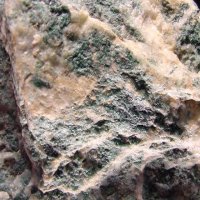
| MARIPOSITE: This anomaly occured only once to our knowledge as a Zuni carving material. Jeff Tsalabutie carved a precious few pieces of it in the late 1990's. It's a whitish stone with green "sprinkles" that comes from an isolated source in California. | |
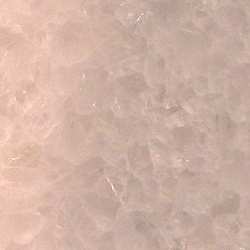
| MARBLE, Colorado White: This type of white marble is used by the Weahkee family and has a more crystalline appearance than other white marbles used in Zuni. We only identify this stone as "Colorado" white marble when the carver tells us it is. | |

| MARBLE, Egyptian: This beautiful and distinctive marble is predominately black with taupe, beige and brown "lightning bolts" throughout. It appeared in Zuni in the late 1990's and was snapped up by carvers (and collectors) very quickly. Not seen as often these days but it's always a delight. It really does come from Egypt. Really. | |

| MARBLE, Picasso: | |
| This is probably the most commonly used carving material in contemporary Zuni. Most of it comes from Utah and it is called "Picasso" marble due to it's abstract veining. Somebody somewhere thought it looked like a Picasso painting. It varies greatly in color. Some specimens will be almost black with muted grey veining. Other specimens will be almost solid brown and every possible variation on this spectrum will occur in the middle. Used by just about EVERYBODY in Zuni at some time or other. Very inexpensive for the carvers to purchase but exceptionally carved fetishes will still command top dollar. |  |
 |
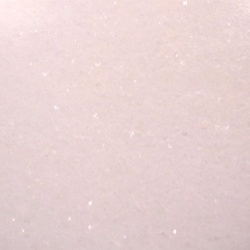
| MARBLE, White: A commonly used material that's pretty much self-explanatory. It comes from Mexico, the US, Europe -- almost anwhere globally. Appreciated most for directional carvings for the eastern direction, i. e., white medicine bear carvings and wolves. | |
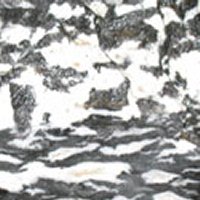
| MARBLE, Zebra: Just as it's name implies this marble is colored like a zebra. As is true with many carving materials, when it appears in Zuni, the carvers rush to buy and create a volume of fetishes and then when it's gone, it's gone. Not a rare material but not (apparently) always available in Zuni. This marble comes from | |
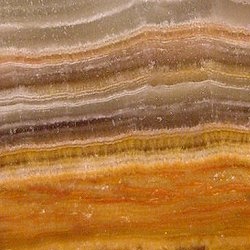
| ONYX: ------------------------------------------------------------------------------------------------------------------------------------------------ | |

| OPAL: ------------------------------------------------------------------------------------------------------------------------------------------------ | |
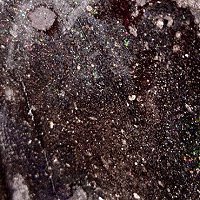
| OPAL, Black Honduran: ------------------------------------------------------------------------------------------------------------------------------------------------ | |
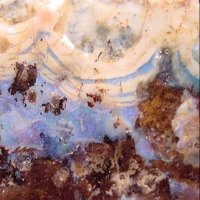
| OPAL, Boulder: ------------------------------------------------------------------------------------------------------------------------------------------------ | |
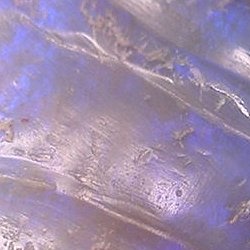
| OPAL, Jelly: ------------------------------------------------------------------------------------------------------------------------------------------------ | |
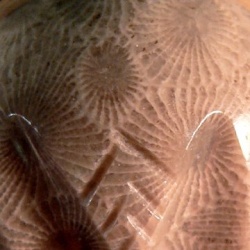
| PETOSKY STONE: ------------------------------------------------------------------------------------------------------------------------------------------------ | |
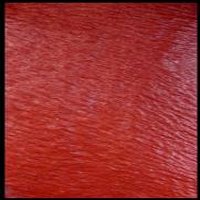
| PIPESTONE: Pipestone (Catlinite) is the sacred red clay stone that American Indians use for making prayer and ceremonial pipes. It has also been used for generations in Zuni for carving fetishes. It is found in only a few places in the world. The best quality pipestone comes from southwestern Minnesota. It ranges in color from pale pink to brick or blood red and normally has small lighter spots - referred to as "stars" - scattered throughout. Pipestone is smooth to the touch, can be easily carved and takes a high polish. | |
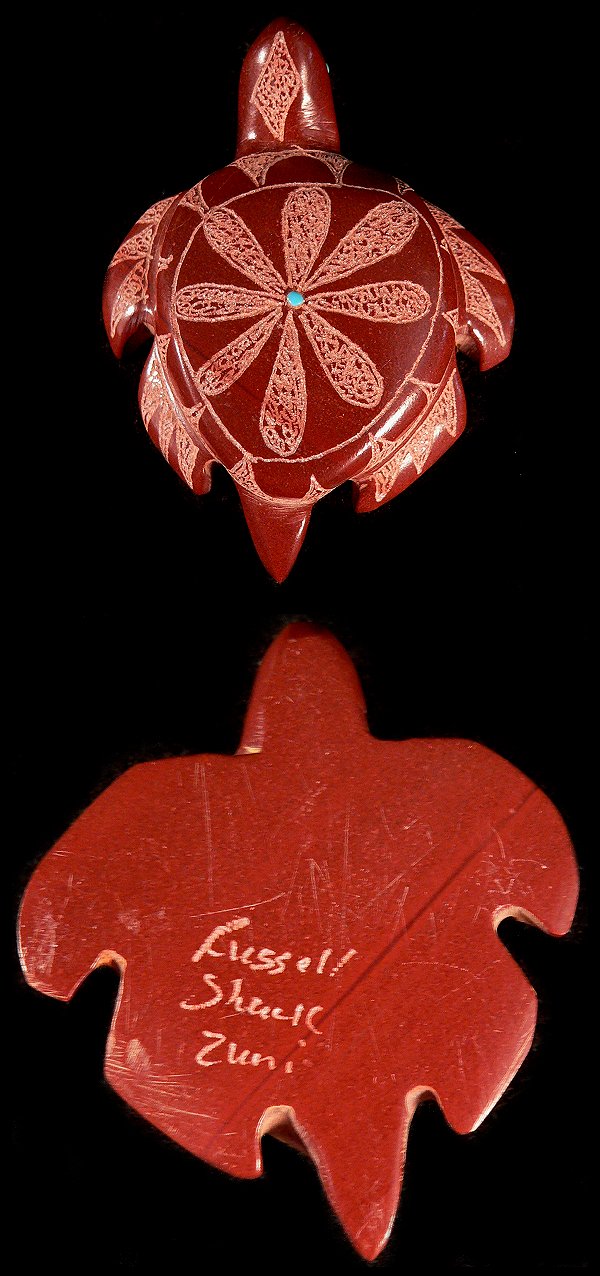
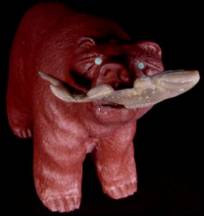
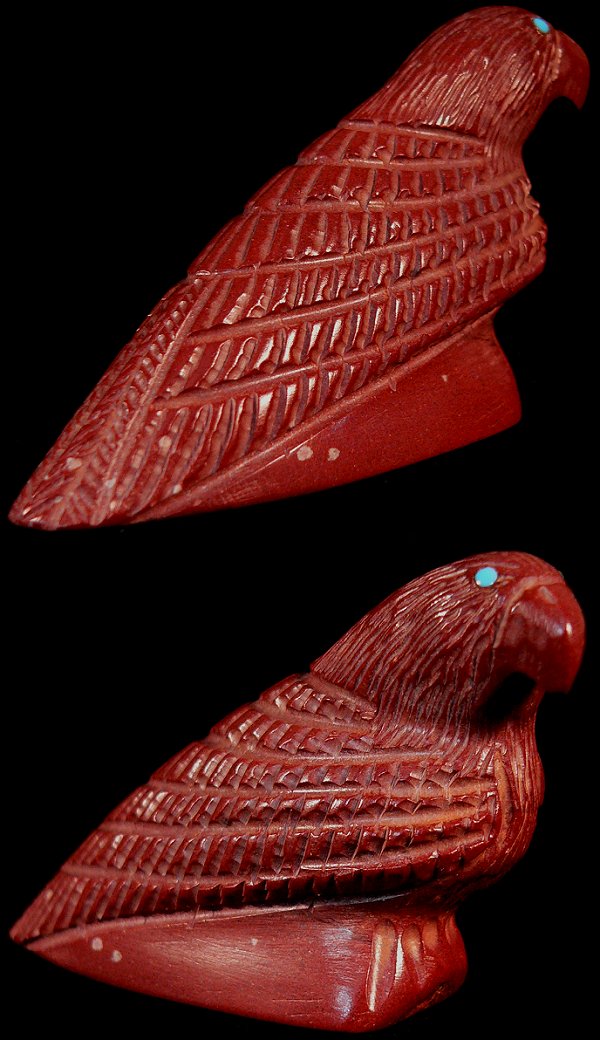
| ||
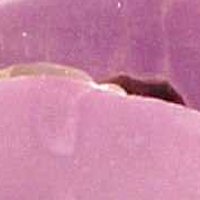
| PHOSPHOSIDERITE: Phosphosiderite is named after its chemical composition, PHOSPHrous and SIDERos, Iron. It can be colorless, purple, pink, red, or violet. Some of this beautiful stone comes from Chile but it is also found in Australia, Tasmania, Portugal and locations in the US. While it is a natural mineral it is stabilized to make it durable and colorfast. | |
 |
||
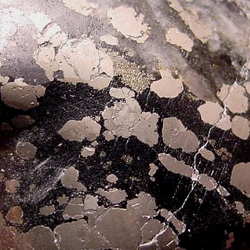
| PYRITE in Matrix: ------------------------------------------------------------------------------------------------------------------------------------------------ | |
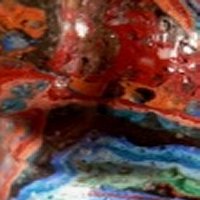
| RAINBOW CALSILICIA: ----------------------------------------------------------------------------------------------------------------------------------------------- | |
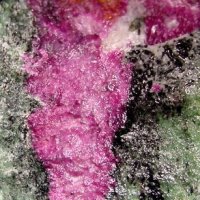
| RUBY ZOISITE: ------------------------------------------------------------------------------------------------------------------------------------------------ | |
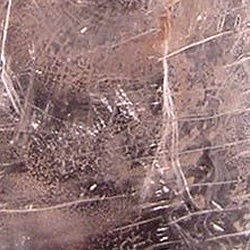
| SELENITE: ------------------------------------------------------------------------------------------------------------------------------------------------ | |
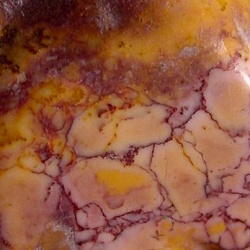
| SERPENTINE: ------------------------------------------------------------------------------------------------------------------------------------------------ | |
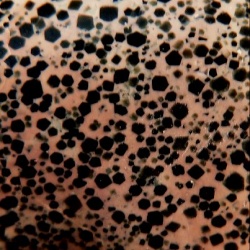
| SERPENTINE, Augite (aka "Spotted Serpentine"): ------------------------------------------------------------------------------------------------------------------------------------------------ | |
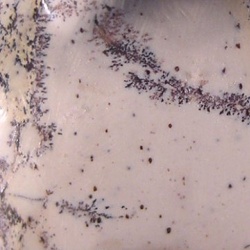
| SERPENTINE, Chocolate (aka "Fishrock"): ------------------------------------------------------------------------------------------------------------------------------------------------ | |
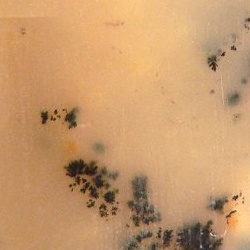
| SERPENTINE, Dendritic : ------------------------------------------------------------------------------------------------------------------------------------------------ | |
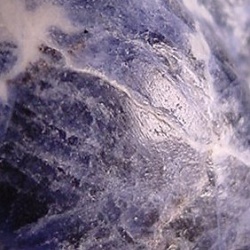
| SODALITE: ------------------------------------------------------------------------------------------------------------------------------------------------ | |
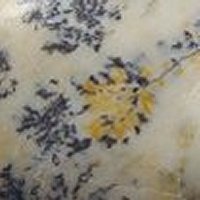
| TALC, DENDRITIC : ------------------------------------------------------------------------------------------------------------------------------------------------ | |
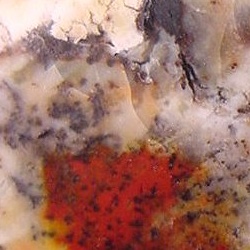
| TIFFANY STONE: ------------------------------------------------------------------------------------------------------------------------------------------------ | |

| TIGEREYE: ------------------------------------------------------------------------------------------------------------------------------------------------ | |
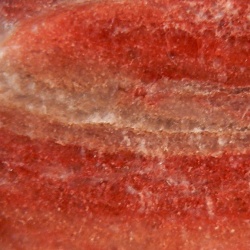
| TRAVERTINE: ------------------------------------------------------------------------------------------------------------------------------------------------ | |
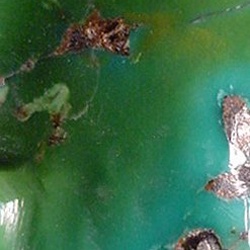
| TURQUOISE, Chinese: ------------------------------------------------------------------------------------------------------------------------------------------------ | |
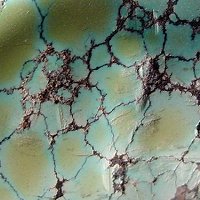
| TURQUOISE, Chinese Hubei: ------------------------------------------------------------------------------------------------------------------------------------------------ | |

| TURQUOISE, Green: ------------------------------------------------------------------------------------------------------------------------------------------------ | |
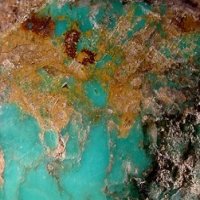
| TURQUOISE, Kingman: ------------------------------------------------------------------------------------------------------------------------------------------------ | |
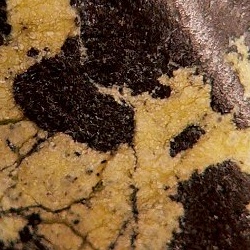
| TURQUOISE, Yellow: ------------------------------------------------------------------------------------------------------------------------------------------------ | |
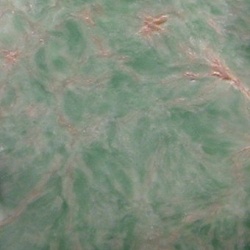
| VARISCITE: ------------------------------------------------------------------------------------------------------------------------------------------------ | |
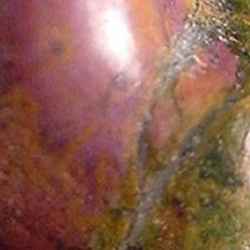
| VERDITE: ------------------------------------------------------------------------------------------------------------------------------------------------ | |
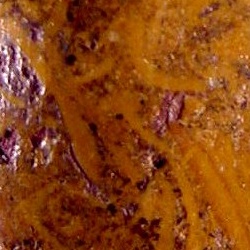
| VIETNAMESE FOSSIL JASPER: ------------------------------------------------------------------------------------------------------------------------------------------------ | |
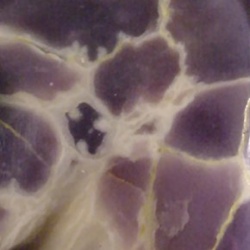
| VIOLITE (aka "Dumortierite"): Dumortierite is a hard, opaque gemstone, usually a dusty denim blue, though rarely violet or pink (Violite). It is sometimes called "Blue Desert Lapis." In fact, it is one of the stones used to substitute for true Lapis and is often sold as "Lapis"! However, it lacks the characteristic gold flakes of true Lapis Lazuli. It is rapidly gaining popularity, probably because it goes well with denim (and because it is a much less expensive alternative to Lapis). It gets its name from the French Paleontologist, Eugene Dumortier. Dumortierite is commonly used as a semi precious/ornamental stone, in the manufacture of high-grade ceramics/porcelain and as mineral specimens. Displaying a vitreous to dull luster, its crystals are translucent to transparent with massive specimens appearing nearly opaque. Having an uneven fracture Dumortierite has a hardness of 7 - 8.5 and a specific gravity of 3.3 - 3.4. Massive quartz colored blue by included Dumortierite crystals is commonly referred to as Dumortierite quartz. Dumortierite, a boro-silicate mineral, is made unusual by its very attractive deep violet blue color. Interestingly, Dumortierite is the most common boro-silicate with the exception of the Tourmaline Group. While not used as a precious gemstone due to a lack of clarity, it displays a bright coloring and good hardness. Massive specimens are carved into cabochons, beads, sculptures, eggs and spheres and in China it has been used as a lapis lazuli imitation. While Dumortierite can be misidentified as other ornamental stones (i.e. sodalite, lazurite and lazulite), blue sodalite is less dense and has whiter portions, while lazurite and lazulite are not fibrous. Dumortierite occurs in Beaunan, France as well as Quartzite, La Paz County, Arizona; Colorado; Oreana, Nevada; New York, New York and Alpine, San Diego County and Los Angeles County, California, USA; Magadanskaya, Siberia, Russia; India and Sahatany, Madagascar. It has many associated minerals including quartz, kyanite, sillimanite, staurolite, andalusite, muscovite, lazulite and pyrophyllite. | |
***************
^ Beam me UP, Scottie! ^ ***************
ZUNI SPIRITS - FINE ZUNI FETISHES DIRECTLY FROM ZUNI PUEBLO, NM
P. O. Box 337, Grapeland, TX 75844
All rights reserved © - Zuni Spirits & Darlene Meader Riggs - 1999 - 2009
Celebrating our TENTH Anniversary in 2009!
Page last updated: 09/01/2014 17:35:18![]()
Web Chick